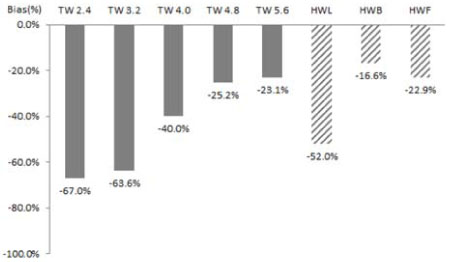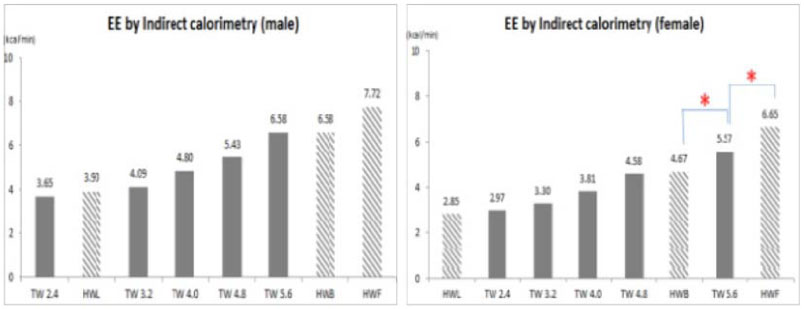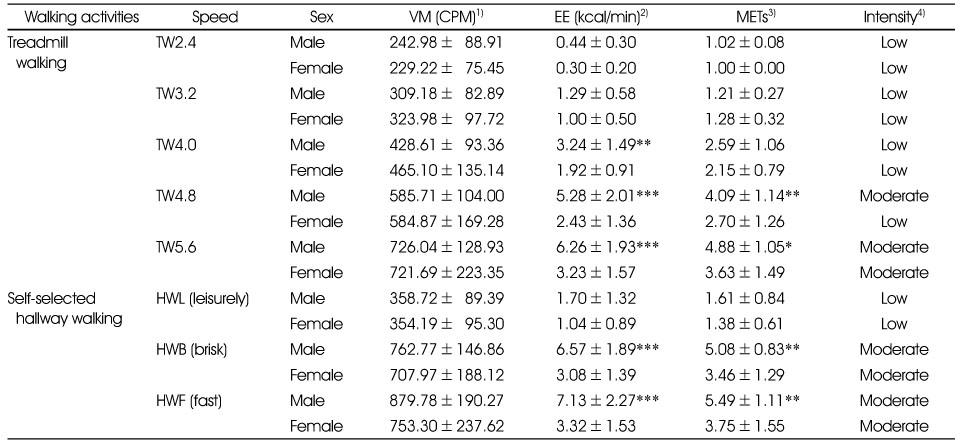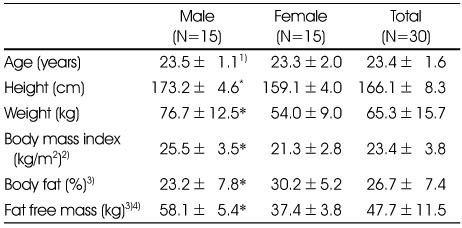Articles
- Page Path
- HOME > Korean J Community Nutr > Volume 21(6); 2016 > Article
-
Research Article
- Measurement of Energy Expenditure Through Treadmill-based Walking and Self-selected Hallway Walking of College Students - Using Indirect Calorimeter and Accelerometer
-
Ye-Jin Kim, Cui-Sang Wang, Eun-Kyung Kim

-
Korean Journal of Community Nutrition 2016;21(6):520-532.
DOI: https://doi.org/10.5720/kjcn.2016.21.6.520
Published online: December 31, 2016
Department of Food and Nutrition, Gangneung-Wonju National University, Gangneung, Korea.
- Corresponding author: Eun-Kyung Kim. Department of Food and Nutrition, Gangneung-Wonju National University, 7 Jukheon - gil, Gangneung, Gangwon-do, 25457, Koera. Tel: (033) 640-2336, Fax: (033) 640-2330, ekkim@gwnu.ac.kr
Copyright © 2016 The Korean Society of Community Nutrition
This is an Open-Access article distributed under the terms of the Creative Commons Attribution Non-Commercial License (http://creativecommons.org/licenses/by-nc/3.0/) which permits unrestricted non-commercial use, distribution, and reproduction in any medium, provided the original work is properly cited.
- 1,316 Views
- 4 Download
- 2 Crossref
Abstract
-
Objectives
- The objective of this study was to assess energy expenditure and metabolic cost (METs) of walking activities of college students and to compare treadmill based walking with self-selected hallway walking.
-
Methods
- Thirty subjects (mean age 23.4 ± 1.6 years) completed eight walking activities. Five treadmill walking activities (TW2.4, TW3.2, TW4.0, TW4.8, TW5.6) were followed by three self-selected hallway walking activities, namely, walk as if you were walking and talking with a friend: HWL (leisurely), walk as if you were hurrying across the street at a cross-walk: HWB (brisk) and walk as fast as you can but do not run: HWF (fast) were performed by each subject. Energy expenditure was measured using a portable metabolic system and accelerometers.
-
Results
- Except for HWF (fast) activity, energy expenditures of all other walking activities measured were higher in male than in female subjects. The lowest energy expenditure and METs were observed in TW2.4 (3.65 ± 0.84 kcal/min and 2.88 ± 0.26 METs in male), HWL (leisurely) (2.85 ± 0.70 kcal/min and 3.20 ± 0.57 METs in female), and the highest rates were observed in HWF (fast) (7.72 ± 2.81 kcal/min, 5.84 ± 1.84 METs in male, 6.65 ± 1.57 kcal/min, 7.13 ± 0.68 METs in female). Regarding the comparison of treadmill-based walking activities and self-selected walking, the energy expenditure of HWL (leisurely) was not significantly different from that of TW2.4. In case of male, no significant difference was observed between energy costs of HWB (brisk), HWF (fast) and TW5.6 activities, whereas in female, energy expenditures during HWB (brisk) and HWF (fast) were significantly different from that of TW5.6.
-
Conclusions
- In this study, we observed that energy expenditure from self-selected walking activities of college students was comparable with treadmill-based activities at specific speeds. Our results suggested that a practicing leisurely or brisk walking for a minimum of 150 minutes per week by both male and female college students enable them to meet recommendations from the Physical activity guide for Koreans.
- 1. Jang YH, Kim SH, Kim YS, Jung SH, Park J. The relationship between walking exercise and quality of life for Korean adults. J Digit converg 2013; 11(5): 325-334.
- 2. Qiu S, Cai X, Schumann U, Velders M, Sun Z, Steinacker JM. Impact of walking on glycemic control and other cardiovascular risk factors in type 2 diabetes: a meta-analysis. PLoS One 2014; 9(10): e109767.ArticlePubMedPMC
- 3. Lee KY, Shin W, Ji MJ. Health promotion research and the development of a walking exercise program. J Basic Sci 2014; 31: 93-106.
- 4. Barnett A, Cerin E, Vandelanotte C, Matsumoto A, Jenkins D. Validity of treadmill- and track-based individual calibration methods for estimating free-living walking speed and VO2 using the Actigraph accelerometer. BMC Sports Sci Med Rehabil 2015; 7: 29.ArticlePubMedPMCPDF
- 5. Han SW, Kong SA. The effect of backward walking and foreward walking on physical fitness in treadmill inclination for women. J coach dev 2006; 8(3): 269-276.
- 6. Korea Centers for Disease Control and Prevention. Korea Health Statistics 2014: Korea National Health and Nutrition Examination Survey (KNHANES VI-2) [Internet]. Korea Centers for Disease Control and Prevention; 2015; cited 2016 Dec 12]. Available from: https://knhanes.cdc.go.kr/.
- 7. Choi HJ, Song JM, Kim EK. Assessment of daily steps, activity coefficient, body composition, resting energy expenditure and daily energy expenditure in female university students. J Korean Diet Assoc 2005; 11(2): 159-169.
- 8. Kim SH. A survey on daily physical activity level, energy expenditure and dietary energy intake by university students in Chungnam province in Korea. J Nutr Health 2013; 46(4): 346-356.Article
- 9. Park Y, Kim JH. Assessment of physical activity pattern, activity coefficient, basal metabolic rate and daily energy expenditure in female university students. Korean J Community Nutr 2013; 18(1): 45-54.Article
- 10. You JS, Chin JH, Kim MJ, Chang KJ. College students' dietary behavior, health-related lifestyles and nutrient intake status by physical activity levels using international physical activity questionnaire (IPAQ) in Incheon area. Korean J Nutr 2008; 41(8): 818-831.
- 11. Park JY, Kim NH. Relationships between physical activity, health status, and quality of life of university students. J Korean Public Health Nurs 2013; 27(1): 153-165.Article
- 12. Kang DW, Choi JS, Mun KR, Tack GR. Estimation of energy expenditure of walking and running based on triaxial accelerometer and physical information. Korean J Sport Biomech 2008; 18(4): 109-114.Article
- 13. Lee MY. Criterion and convergent validity evidences of an Accelerometer and a Pedometer. Korean J Meas Eval Phys Educ Sport Sci 2012; 14(2): 1-13.
- 14. Miller NE, Strath SJ, Swartz AM, Cashin SE. Estimating absolute and relative physical activity intensity across age via accelerometry in adults. J Aging Phys Act 2010; 18(2): 158-170.ArticlePubMedPMC
- 15. Lyden K, Kozey SL, Staudenmeyer JW, Freeson PS. A comprehensive evaluation of commonly used accelerometer energy expenditure and MET prediction equations. Eur J Appl Physiol 2011; 111(2): 187-201.ArticlePubMedPDF
- 16. Peterson NE, Sirard JR, Kulbok PA, Deboer MD, Erickson JM. Validation of accelerometer thresholds and inclinometry for measurement of sedentary behavior in young adult university students. Res Nurs Health 2015; 38(6): 492-499.ArticlePubMedPMC
- 17. Plotnik M, Azrad T, Bondi M, Bahat Y, Gimmon Y, Zeiling G. Self-selected gait speed-over ground versus self-paced treadmill walking, a solution for a paradox. J Neuroeng Rehabil 2015; 12: 20.ArticlePubMedPMCPDF
- 18. Hall KS, Howe CA, Rana SR, Martin CL, Morey MC. METs and accelerometry of walking in older adults: standard versus measured energy cost. Med Sci Sports Exerc 2013; 45(3): 574-582.PubMedPMC
- 19. Schrack JA, Simonsick EM, Ferrucci L. Comparison of the Cosmed K4b(2) portable metabolic system in measuring steady-state walking energy expenditure. PLoS One 2010; 5(2): e9292.ArticlePubMedPMC
- 20. Vanhelst J, Mikulovic J, Bui-Xuan G, Dieu O, Blondeau T, Fardy P. Comparison of two actigraph accelerometer generations in the assessment of physical activity in free living conditions. BMC Res Notes 2012; 5(1): 187.ArticlePubMedPMCPDF
- 21. Actigraph Support Center. What is VM (Vector Magnitude)? [Internet]. Actigraph Support Center; 2016; cited 2016 Nov 28]. Available from: http://actigraphcorp.com.
- 22. Ainsworth BE, Haskell WL, Whitt MC, Irwin ML, Swartz AM, Strath SJ. Compendium of physical activities: an update of activity codes and MET intensities. Med Sci Sports Exerc 2000; 32: 9 suppl. S498-S504.ArticlePubMed
- 23. Ministry of Health and Welfare. The physical activity guide for Koreans. Ministry of Health and Welfare; 2013.
- 24. Kang IW, Cho WJ. The influence on mental health status and health-related quality of life in middle-aged women by the regular walking exercise. J Korea Soc Wellness 2016; 11(1): 207-215.
- 25. Choi YY, Choi SB, Kim SG. The relationship between physical self-concept and subjective happiness according to walking exercise participation type. Korean J Sport 2011; 9(2): 1-12.
- 26. Jeon JS. Walking efficiency by obesity. Proceedings of The 8th Korea Walking Festival Seminar. 2002 10 25. p. 94-107.
- 27. Lee MH, Kim DY, Nam DH. Validation of the GT1M and GT3X Accelerometers for assessment of physical activity. Korean J Meas Eval Phys Educ Sport Sci 2012; 14(2): 61-71.Article
- 28. Webb P. Energy expenditure and fat-free mass in men and women. Am J Clin Nutr 1981; 34(9): 1816-1826.ArticlePubMed
- 29. An JH. The model for the walking and running program for the health of the aged. J Korean Phys Soc 1996; 35(3): 299-308.
- 30. Hunnicutt JL, Aaron SE, Embry AE, Cence B, Morgan P, Bowden MG, et al. The effects of power training in young and older adults after stroke. Stroke Res Treat 2016; 10.1155/2016/7316250.ArticlePDF
- 31. Bayle N, Patel AS, Crisan D, Guo LJ, Hutin E, Weisz DJ. Contribution of step length to increase walking and turning speed as a marker of Parkinson's disease progression. PLoS One 2016; 11(4): e0152469.ArticlePubMedPMC
- 32. Seale JL, Rumpler WV. Synchronous direct gradient layer and indirect room calorimetry. J Appl Physiol 1997; 83(5): 1775-1781.ArticlePubMed
- 33. Jeong SM, Kim TH, Park CH, Kim HG, Jekal YS. Review and introduction of physical activity assesment actigraph. J Exerc Sport Sci 2013; 19: 31-41.
- 34. Freedson PS, Melanson E, Sirard J. Calibration of the computer science and applications, Inc. accelerometer. Med Sci Sports Exerc 1998; 30(5): 777-781.ArticlePubMed
- 35. World Health Organization. Global Strategy on Diet, Physical Activity and Health [Internet]. World Health Organization; 2016; cited 2016 Dec 12]. Available from: http://www.who.int/dietphysicalactivity/factsheet_adults/en/.
- 36. Park DH, Kim CS, Kim KJ. Consideration about physical activity guideline and exercise intensity for adult. Exerc Sci 2015; 24(2): 100-107.
- 37. Lee MY, Choi JY. Accuracy of wearable devices to estimate physical activity levels. Korean J Meas Eval Phys Educ Sport Sci 2015; 17(2): 49-60.Article
REFERENCES
Assessment of predicted METs by accelerometer based on bias

Comparison of energy expenditure of treadmill walking and self-selected hallway walking

Energy costs of walking activities measured by indirect calorimeter

1) VO2: Volume of oxygen consumption
2) EE: Energy expenditure
3) METs: Metabolic equivalents
4) Compendium of physical activities: METs intensities (Ainsworth BE et al 2000) Low: <3.0 METs, Moderate: 3.0 − 6.0 METs, Vigorous: >6.0 METs
*: p < 0.05, **: p < 0.01, ***: p < 0.001, significantly different between male and female by Mann-Whitney u test
VM (vector magnitude) and METs of walking activities measured by accelerometer

1) CPM: Counts per minute
2) EE: Energy expenditure
3) METs: Metabolic equivalents
4) Compendium of physical activities : METs intensities (Ainsworth BE et al 2000) Low: <3.0 METs, Moderate: 3.0 − 6 METs, Vigorous: >6.0 METs
*: p < 0.05, **: p < 0.01, ***: p < 0.001, significantly different between male and female by Mann-Whitney test
Figure & Data
REFERENCES
Citations

- Accuracy of Accelerometer for the Prediction of Energy Expenditure and Activity Intensity in Athletic Elementary School Children During Selected Activities
Su-Ji Choi, Hae-Sun An, Mo-Ran Lee, Jung-Sook Lee, Eun-Kyung Kim
Korean Journal of Community Nutrition.2017; 22(5): 413. CrossRef - Energy expenditure of physical activity in Korean adults and assessment of accelerometer accuracy by gender
Yeon-jung Choi, Mun-jeong Ju, Jung-hye Park, Jong-hoon Park, Eun-kyung Kim
Journal of Nutrition and Health.2017; 50(6): 552. CrossRef


Fig. 1
Fig. 2
Descriptions of 8 walking activities
1) TW: treadmill walking
2) HWL: hallway walking leisurely
3) HWB: hallway walking brisk
4) HWF: hallway walking fast
Anthropometric measurements of subjects
1) Mean±SD
2) Weight (kg) / [Height (m)]2
3) Measured by Inbody 720
4) Weight (kg) − Fat mass (kg)
*: p < 0.05, Significantly different between male and female by Mann-Whitney test
Energy costs of walking activities measured by indirect calorimeter
1) VO2: Volume of oxygen consumption
2) EE: Energy expenditure
3) METs: Metabolic equivalents
4) Compendium of physical activities: METs intensities (Ainsworth BE et al 2000) Low: <3.0 METs, Moderate: 3.0 − 6.0 METs, Vigorous: >6.0 METs
*: p < 0.05, **: p < 0.01, ***: p < 0.001, significantly different between male and female by Mann-Whitney u test
VM (vector magnitude) and METs of walking activities measured by accelerometer
1) CPM: Counts per minute
2) EE: Energy expenditure
3) METs: Metabolic equivalents
4) Compendium of physical activities : METs intensities (Ainsworth BE et al 2000) Low: <3.0 METs, Moderate: 3.0 − 6 METs, Vigorous: >6.0 METs
*: p < 0.05, **: p < 0.01, ***: p < 0.001, significantly different between male and female by Mann-Whitney test
Comparison of energy expenditure by indirect calorimeter and accelerometer
1) Mean±SD
**: p < 0.01, ***: p < 0.001, significantly different between indirect calorimeter and accelerometer by paired t-test
Correlation coefficients between energy expenditures measured by indirect calorimeter and accelerometer
*: p < 0.05, **: p < 0.01, significant correlation at by correlation
1) TW: treadmill walking 2) HWL: hallway walking leisurely 3) HWB: hallway walking brisk 4) HWF: hallway walking fast
1) Mean±SD 2) Weight (kg) / [Height (m)]2 3) Measured by Inbody 720 4) Weight (kg) − Fat mass (kg) *: p < 0.05, Significantly different between male and female by Mann-Whitney test
1) VO2: Volume of oxygen consumption 2) EE: Energy expenditure 3) METs: Metabolic equivalents 4) Compendium of physical activities: METs intensities (Ainsworth BE et al 2000) Low: <3.0 METs, Moderate: 3.0 − 6.0 METs, Vigorous: >6.0 METs *: p < 0.05, **: p < 0.01, ***: p < 0.001, significantly different between male and female by Mann-Whitney u test
1) CPM: Counts per minute 2) EE: Energy expenditure 3) METs: Metabolic equivalents 4) Compendium of physical activities : METs intensities (Ainsworth BE et al 2000) Low: <3.0 METs, Moderate: 3.0 − 6 METs, Vigorous: >6.0 METs *: p < 0.05, **: p < 0.01, ***: p < 0.001, significantly different between male and female by Mann-Whitney test
1) Mean±SD **: p < 0.01, ***: p < 0.001, significantly different between indirect calorimeter and accelerometer by paired t-test
*: p < 0.05, **: p < 0.01, significant correlation at by correlation

 KSCN
KSCN




 Cite
Cite


